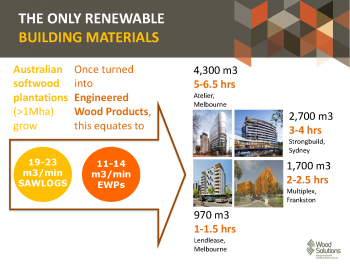
Our buildings are becoming increasingly operationally efficient from our improving electricity grids, cost reductions in renewable energy and the improved construction code standards for building performance. As operationally energy impacts reduce, the proportion of environmental impacts that come from embodied energy is increasing. Therefore the spotlight is shifting towards materials with a growing understanding that there is a need for renewable sources, as there is for our consumption of energy.
Solar and wind are the cost competitive and renewable solution for energy, sustainably managed wood is a cost competitive and renewable solution for materials.
A product obtained from a natural resource which through the process of photosynthesis and using the solar energy of the sun converts CO2 to the oxygen that we breathe and to carbon which is stored in the woody mass of the trees.
Around half the dry weight of wood is carbon – so a hardwood product of a density of 1,000kg/m3 stores around 500kg/m3 of carbon, multiply this by 3.66 and that is how much CO2 is stored in the wood. The carbon sequestered will remain stored for the life of the wood product.
At the end of the products first-life, timber products have a great opportunity to be directly reused (doors, windows, floors, etc) or and recycled/reprocessed into other wood-based products. When a wood product can no longer be reused or recycled it can be utilised as a co-generation fuel in biomass energy plants, reducing the reliance on non-renewable fossil fuels such as coal, - the CO2 released from the burning of the timber goes back to the atmosphere where ultimately it may be absorbed by other growing trees. It provides a very positive cradle-to-cradle lifecycle or carbon cycle story for wood products.
Resources
There are a variety of free resources which allow you to learn more about the environmental impact of your project.
1. The WoodSolutions 'The Ultimate Renewable' campaign provides a wide range of free, independent, and reliable information regarding the environmental impact of using wood in construction. Visit the 'The Ultimate Renewable' campaign page here.
2. The Planet Ark 'Make It Wood' campaign also provides a wide variety of independent information on topics ranging from the benefits of specifying wood, to the health and wellbeing impacts, and even inspiring project case studies. Visit the Make It Wood Website here.
3. The US Environmental Protection Agency host a 'Greenhouse Gas Equivalencies Calculator' which allows your to convert the amount of sequestered CO2 in your project to other, easily understood metrics (e.g., X number of homes' electricity use for one year). You can find this resource here.
4. Hyne Timber provide an 'Environmental Calculator' which allows the user to calculate both the carbon footprint of using various timber products, as well as the amount of time it took to grow the amount of softwood timber products used. You can find this resource here.
